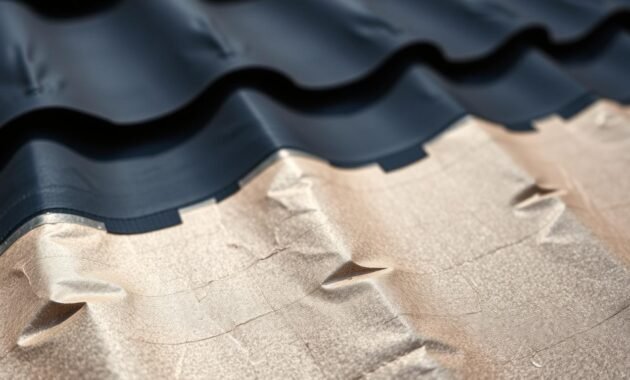Leaky roofs can cause a lot of damage to your home, costing thousands of dollars. Moisture can quietly harm the structure of your home. Roofing felt, or tar paper, is a key defense against water damage.
I’ve seen many roofing projects where tar paper saved the day. It’s a strong layer between the roof decking and the outer roofing. It protects your home from the elements.
Knowing how tar paper works can help keep your home safe and avoid expensive repairs. This article will dive into how tar paper keeps your roof dry and strong.

Understanding Roofing Underlayment Basics
Roofing underlayment is key to a strong roof. As a construction pro, I’ve seen how it keeps homes safe from moisture and damage.
Roofing experts know three main types of underlayment. They are vital for homes and businesses:
- Asphalt impregnated felt paper
- Synthetic underlayment
- Rubberized asphalt underlayment
Primary Functions of Roof Underlayment
Roof underlayment does more than just protect. It has several important roles:
- Acts as a secondary water barrier
- Keeps roof decking dry
- Adds insulation
- Makes the roof last longer
Historical Development of Roofing Materials
Roofing underlayment has changed a lot over time. Old asphalt materials are now replaced by better synthetic ones. This shows how construction tech keeps getting better.
Knowing about roofing underlayment helps homeowners and builders. It helps protect their buildings’ strength.
What is Tar Paper
Tar paper is a key part of roofing systems. It’s used by many homeowners and contractors for protection. It acts as a barrier between the roof deck and the top roofing layer. Despite its name, today’s tar paper is made from asphalt, not tar.
Looking into tar paper, you’ll find it’s a flexible roofing material sold in rolls. Each roll has a base material, like organic felt or fiberglass, soaked in asphalt or bitumen. This makes a water-resistant layer that protects buildings from moisture and damage.
- Composed of natural or synthetic fibers
- Saturated with petroleum-based asphalt
- Sold in convenient roll formats
- Provides critical moisture protection
Creating tar paper involves treating base materials to make them durable and water-resistant. Contractors like it for its reliability and easy installation. Each roll has specific weight and thickness, affecting its performance.
Even though tar paper has been around for years, new roofing technologies keep improving it. Homeowners and builders see tar paper as a vital layer for a strong roof.
The Composition and Manufacturing of Tar Paper
Tar paper is a key part of construction, made through a detailed process. It turns raw materials into a strong roofing option. This process creates a solid barrier for buildings.
The making of tar paper starts with picking the right base materials. These materials affect how well the tar paper works and lasts. There are two main types used:
- Organic fiber materials (wood-based cellulose)
- Synthetic fiber composites
Natural Material Components
Choosing the right base material is key for quality tar paper. Organic fibers like wood pulp soak up water well. Synthetic fibers, on the other hand, are stronger and last longer against the weather.
Bitumen Treatment Process
The asphalt treatment makes tar paper water-resistant. The base material is covered in hot bitumen. This creates a layer that keeps water out, making the tar paper strong against bad weather.
Quality Control Standards
Quality checks are strict to make sure tar paper is reliable. Tests are done to check:
- How well the bitumen is applied
- If the material is the right thickness
- How well it resists water
- Its strength
| Material Type | Water Resistance | Durability Rating |
|---|---|---|
| Organic Fiber Tar Paper | Good | Medium |
| Synthetic Fiber Tar Paper | Excellent | High |
Knowing how tar paper is made shows the advanced engineering behind it. This is important for both professionals and homeowners.
Key Benefits of Tar Paper in Roofing Systems

Tar paper is a key moisture barrier for roofs. It offers protection that many homeowners don’t think about. This material is essential for keeping roofs safe.
The main benefits of tar paper are:
- It’s very good at keeping water out
- It protects the roof decking from damage
- It makes the roof last longer
- It also helps with keeping warm in and cold out
Tar paper acts as a strong shield against water. It keeps the roof’s structure safe from damage. This stops wood rot, mold, and damage that can harm a building.
Roofing experts like tar paper because it’s affordable. It’s a key layer between the roof and the decking. It helps the roof last longer and saves money on repairs.
Using tar paper can make a roof last longer. It keeps water out and adds insulation. This makes it a key part of modern roofs.
Tar Paper vs Synthetic Underlayment: A Comparison
Choosing the right underlayment for your roof is key to its performance and life. Knowing the difference between tar paper and synthetic underlayment helps homeowners make better choices.
When picking underlayment, consider several factors. These impact your home’s safety and the roof’s overall performance.
Cost Considerations
Tar paper is cheaper for those on a tight budget. Synthetic underlayment costs more but lasts longer and offers better protection.
| Underlayment Type | Average Cost per Square | Lifespan |
|---|---|---|
| Tar Paper | $0.20 – $0.50 | 5-10 years |
| Synthetic Underlayment | $0.75 – $1.50 | 25-40 years |
Durability Factors
- Tar paper offers basic moisture protection
- Synthetic underlayment provides superior weather resistance
- Synthetic materials are lighter and more tear-resistant
Installation Requirements
Installing tar paper and synthetic underlayment differs. Roofers often prefer synthetic for its ease of use.
- Tar paper requires precise overlapping
- Synthetic underlayment offers wider coverage areas
- Synthetic materials have improved grip for worker safety
Installation Techniques and Best Practices
When working on a roofing project, knowing how to install tar paper is key. I’ve found that a good installation needs careful prep and precision. This ensures the roof stays protected.
- Clean the roof deck well before starting
- Make sure the surface is dry and clear of debris
- Begin at the roof’s lowest point and move up
- Overlap each tar paper row by 2-4 inches
- Secure it with roofing nails or staples
The process can be tough because tar paper is heavy and smooth. It’s smart to wear non-slip shoes and use safety gear. Paying close attention to details helps avoid water leaks and keeps the roof safe for a long time.
Important things to keep in mind during installation are:
- Keep the overlap even to stop water leaks
- Avoid wrinkles or air pockets under the tar paper
- Seal edges and corners with roofing cement
- Check for any tears or damage while installing
By sticking to these best practices, contractors can make a roofing project that lasts. It will also keep the building dry and safe.
Read also: The Reasons to Use Roof Drain with Overflow
Weather Protection and Moisture Resistance Features
Tar paper is key in keeping homes safe from the weather. It stops moisture from getting inside, protecting your home from damage. It’s a must-have for keeping your roof strong and dry.
Water Barrier Effectiveness
Tar paper acts as a strong shield against water. It keeps moisture out, even when the roof gets damaged. This layer is vital in stopping water from reaching the roof’s core.
- Blocks water penetration
- Provides secondary moisture protection
- Prevents structural water damage
Temperature Performance Characteristics
Tar paper stands up well to all kinds of temperatures. It works in both hot and cold, keeping your roof safe all year. Its ability to handle different temperatures means it always does its job.
| Temperature Range | Performance Rating | Moisture Resistance |
|---|---|---|
| -20°F to 200°F | Excellent | High |
| Extreme Cold | Good | Moderate |
| Intense Heat | Very Good | Superior |
Knowing how tar paper protects your home is important. It’s a top choice for keeping your roof safe from moisture. Its waterproofing is a big reason it’s used in roofing today.
Common Applications and Usage Scenarios

Tar paper is key in many roofing projects and construction. It’s versatile and protects structures from moisture and the environment. Contractors use it in both homes and businesses.
In homes, tar paper is a vital underlayment for various roofs. It keeps homes safe from moisture when installing:
- Asphalt shingles
- Wood shake roofing
- Metal roof systems
- Tile roofing installations
For professional roofing, tar paper is used to fight moisture. It adds a layer of protection against water, keeping the roof safe.
Read also: An Expert Way to Get Tar Off a Skin
| Roofing Application | Tar Paper Usage | Primary Benefit |
|---|---|---|
| Residential Roofs | Underlayment layer | Moisture protection |
| Commercial Buildings | Roof deck covering | Water resistance |
| Shed Construction | Temporary weatherproofing | Surface protection |
Tar paper is also used in special projects. It’s affordable and keeps water out, making it great for temporary structures and small buildings.
Maintenance and Longevity Considerations
Keeping your roof strong means knowing how long and how to care for roofing tar paper. It’s a key shield against moisture and damage. So, it’s important to give it the right care.
The life of roofing tar paper depends on a few important things. Homeowners need to watch these closely. Tar paper usually lasts 15-30 years, but it can vary.
Key Lifespan Factors
- Climate exposure
- Quality of initial installation
- Roofing material type
- Maintenance frequency
Replacement Indicators
Knowing when to replace your tar paper is key. Look out for these signs:
- Visible tears or punctures
- Significant granule loss
- Water stains on interior ceilings
- Curling or separation from roof deck
| Condition | Action Required |
|---|---|
| Minor surface damage | Professional inspection recommended |
| Extensive deterioration | Complete underlayment replacement |
| Water penetration evidence | Immediate professional assessment |
Getting regular checks from pros can help your tar paper last longer. I suggest getting a full roof check every 3-5 years. This way, you can spot problems early and keep your home safe from the elements.
Conclusion
As a roofing expert, I’ve seen many projects where tar paper shines. Roofing felt is key in keeping homes safe from moisture and weather. Tar paper is a trusted underlayment that helps roofs last longer and work better.
Tar paper is very versatile. Even with new synthetic options, traditional roofing felt is reliable for many roofs. It acts as a water barrier, protecting the roof deck and the main roofing materials.
Homeowners and contractors should think about their roofing needs carefully. Some jobs might need tar paper, while others might do better with synthetic underlayment. Knowing the differences helps make smart choices that keep your property safe.
In the end, tar paper is more than just a layer of protection. It shows how roofing tech has improved to better protect buildings. Whether you’re starting a new roof or updating an old one, understanding tar paper’s benefits can help you choose the right path.




